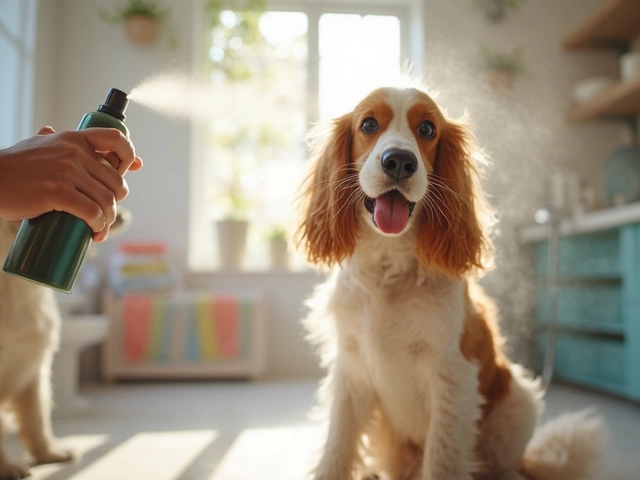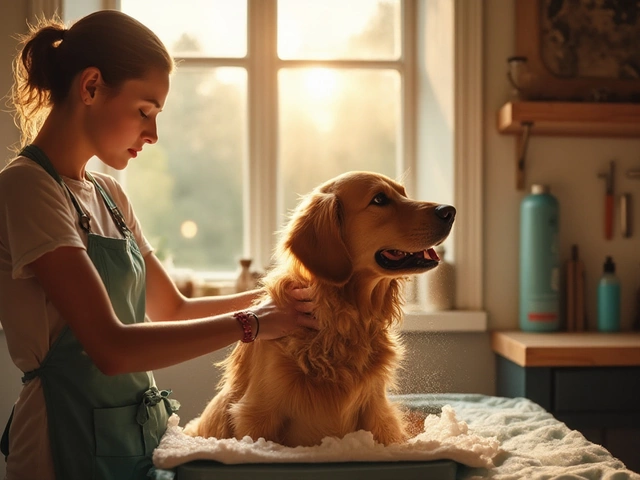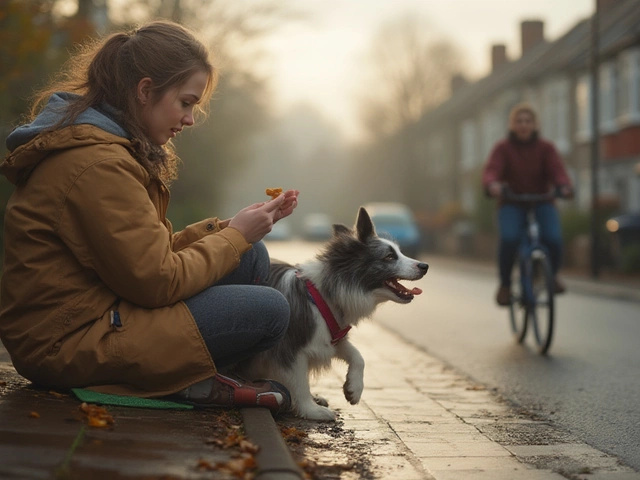The first time my son Gideon got his fingers nipped by our puppy, he howled louder than the dog. If you’re dealing with puppy bites or a dog that gets overexcited and nips, you’re not alone. Biting can seem cute at first—until it suddenly isn’t. The good news: dogs can learn to stop biting, no matter their age.
Start by figuring out why your dog is biting. Is it teething, fear, play, or frustration? Knowing the trigger helps a ton, because each reason needs a slightly different approach. Puppies bite everything when teething, just like toddlers toss stuff during tantrums. If your dog’s a little older and still biting, it could be nerves or lack of boundaries.
Here’s where it gets practical. Interrupt bites with a sharp, calm "Nope!" or "Ouch!" and then stop playing for a few seconds. This shows your dog that biting means the fun ends. They want to play with you, not get ignored. Keep things simple and repeat every time. Dogs learn best with patience and consistency.
- Why Dogs Bite and Why It Matters
- Spotting Early Warning Signs
- Easy and Proven Training Techniques
- Avoiding Common Mistakes
- Making Training Stick for Good
Why Dogs Bite and Why It Matters
When you see a dog bite, it’s rarely random. Most dogs bite for clear reasons, and understanding those reasons is the first step to changing the behavior. Puppies usually bite because they’re exploring their world, kind of like a baby shoving everything in their mouth. As puppies grow, nipping can also be their way of playing with you since that’s how they play with other dogs.
Older dogs might bite because they’re scared, protecting their territory, or feel pain. Stressful situations, being startled, or rough handling can all trigger bites even in dogs that usually seem calm. When a dog hasn’t been taught bite control as a puppy, that habit can stick around into adulthood and land them in serious trouble, which is why it’s so important to train dog stop biting early.
Bite incidents happen way more often than most people think. According to the American Veterinary Medical Association, about 4.5 million people in the US get bitten by dogs each year, and half of those are kids. It’s one of the top reasons why kids end up in the ER with animal injuries. Here’s a clear snapshot:
| Age Group | % of Dog Bite Victims |
|---|---|
| Children (under 15) | 50% |
| Adults | 50% |
There’s a ripple effect from ignoring dog biting. Injuries can lead to fear in kids and adults, trouble with neighbors, and even the heartbreaking decision to rehome a dog. Some cities even have rules about reporting or punishing repeated biters, which puts extra pressure on owners.
If you catch the biting when your dog is young, it’s much easier to fix. But even for older dogs, all hope is not lost—understanding their trigger makes the next steps way more effective. Ignoring it never works; tackling the root cause helps your dog, your family, and your community stay safer.
Spotting Early Warning Signs
Before a dog actually bites, there are usually warning signs. Recognizing them early can save you or your kids from a bad experience. Dogs don’t just "snap" out of nowhere. Even puppies who nip while playing show little hints first.
Watch for things like:
- Yawning when not tired (sign of stress)
- Licking their lips a lot
- Turning their head away or walking off
- Whale eye (you can see the whites of their eyes)
- Growling, stiff body, or raised fur
Puppies often get wiggly before they pounce or nip. If their tail is wagging high or their body suddenly gets still, pay attention. These are signals your dog isn’t relaxed.
It’s common to miss these clues, especially if you haven’t trained a dog before. According to a survey done by the American Veterinary Medical Association, over 4.5 million people in the U.S. get bitten by dogs every year — over half are kids under 12. Most bites could have been avoided by recognizing early signals of discomfort or excitement.
| Warning Sign | What It Usually Means |
|---|---|
| Yawning | Feeling stressed or overwhelmed |
| Lip Licking | Nervousness or uncertainty |
| Growling | Wants more space or feeling threatened |
| Whale Eye | Feeling tense, not happy with the situation |
When you spot any of these, stop what you’re doing and give your dog (or puppy) a second to chill. Try not to punish the warning signs — a growl is your dog talking to you. Taking away their right to warn only makes biting more unpredictable. Make spotting these clues a habit, especially around kids. The sooner you notice, the easier it is to train dog stop biting before things get serious.

Easy and Proven Training Techniques
If you want to train dog stop biting for good, you need simple routines that anyone in the house can follow. Dogs don’t learn from lectures or guilt trips. They notice what gets them attention—and what doesn’t. Training a dog to stop biting is about breaking old habits and setting new, clear expectations.
First up, teach bite inhibition. This means your dog learns how to control the pressure of their mouth. When they bite too hard, yelp loudly (you’ll feel silly, but it works) and pull your attention away. Dogs understand this in a way that words alone don’t cover—think of how their littermates react to a nip.
- Always play with safe chew toys and redirect them if teeth make contact with skin. Keep a toy handy so you never reward biting skin, even by accident.
- Use short, consistent commands like “Ah-ah!” or “No bite.” No need to shout or repeat these a million times. Calm and firm says it best.
- Reward gentle play with treats or praise right when it happens. Make it clear that calm mouths get good stuff.
If your dog gets too wild, call a short “time-out.” Just remove yourself or the dog from the situation for thirty seconds. This pause shows that rough play kills the fun.
Don’t forget about regular exercise and mental stimulation. A bored or under-exercised dog bites way more often because they’ve got energy to burn. Walks, fetch, puzzle feeders—every bit helps calm their urge to nip.
For families with kids, set ground rules: no rough wrestling, no teasing, and always use toys during playtime. Little ones can accidentally encourage nipping by waving hands and running, so always supervise and teach them to stand still when excited.
Stick with it, and the biting will fade. Dogs just want to please, but they need to know exactly how. Daily practice and everyone sticking to the same plan makes all the difference.
Avoiding Common Mistakes
A lot of people slip up without realizing when trying to train dog stop biting. Let’s break down the usual traps and how to sidestep them for faster results. Fixing these early will save you from frustration (and ruined slippers).
- Yelling or Physical Punishment: It’s tempting to shout or swat when you get nipped. The trouble is, this just scares your dog and makes biting worse. According to a 2023 survey by the American Veterinary Society of Animal Behavior, dogs trained with punishment are more likely to develop aggression later.
- Inconsistent Responses: If you let your dog bite sometimes—say, during rough play—but scold her at other times, she’ll get confused fast. Same rules, always. Everyone in the house should react the same way when the biting happens.
- Letting Kids Tease or Play Rough: Kids like Gideon don’t always get dog body language. High-pitched squeals, waving hands, or tug toys near faces can make puppies ramp up their biting. Teach your kids how to play gently and always supervise at first.
- Skipping Outlets for Energy: Dogs full of pent-up energy are much more likely to bite or nip. Make time for walks, fetch, or chew toys. One study in 2022 found that regular playtime cut unwanted biting by almost 50% in dogs under two years old.
- Ignoring Tooth Trouble: Puppies (and even older dogs) in pain from teething or bad teeth might bite more. If you notice drooling, bleeding gums, or chewing that seems desperate, check with the vet.
When in doubt, remember: redirection trumps punishment every single time. Always offer a chew toy when your dog mouths you or a family member. The faster you notice and redirect, the quicker they learn what’s okay to bite—and what’s not.
| Mistake | Consequence |
|---|---|
| Yelling/Harsh Punishment | Increases anxiety, more biting |
| Inconsistent Rules | Dog gets confused, slower learning |
| Poor Supervision of Kids | Higher risk of bites, scared dog |
| Not Enough Exercise | Dog gets bored, nips more |
| Ignoring Dental Health | Pain bites, vet bills |
Steering clear of these common traps puts you and your dog on the right path to a safer, bite-free home.

Making Training Stick for Good
It’s one thing to get your dog to stop biting for a few days, but making the habit stick is a whole different game. Dogs, just like kids, need daily reminders. Consistency is your secret weapon. Everyone in the house should react the same way when your dog tries to bite—otherwise, your pup gets mixed signals, and nothing changes.
Pulling it off means making the rules part of your daily routine. You don’t have to be drill-sergeant strict, but you can’t let things slide. If Grandma giggles when the dog nips her, the dog will think, "Well, sometimes it’s fine," and bite again next time.
Here’s a simple plan to help you hold the line long-term:
- Set clear rules for everyone: Make sure every family member knows what to do when the biting happens. No exceptions.
- Reward good behavior: Always catch your dog doing the right thing and give out treats and praise. Dogs remember positive attention.
- Keep bite-proof toys handy: Redirect your dog to chew approved toys every single time. If they’re teething, frozen carrots can help soothe sore gums.
- Practice outside the house: Dogs often behave differently in new places. Practice your training at the park, on walks, and even at friends’ homes.
- Don’t slack off: Even after the biting stops, keep reinforcing the right behavior from time to time. Lapses happen if you change the routine.
It really helps to track your dog’s progress. Here’s a simple way to keep tabs:
| Week | Number of Biting Attempts | Training Action Taken |
|---|---|---|
| 1 | 12 | Stopped play, used calm cues |
| 2 | 7 | Added more toy redirection |
| 3 | 3 | Practiced at park, kept rewards ready |
| 4 | 1 | Quick reaction, praised non-biting |
If your dog keeps at it or you’re not seeing progress after a few weeks, don’t give up. Sometimes you need a pro—getting advice from a certified dog trainer or taking group classes can make all the difference. About 95% of dogs respond to steady training, but every dog’s different, so a little extra help never hurts.
Stick with these steps and you’ll see changes. Your dog will learn quickly which behaviors get attention, which get ignored, and—most importantly—what not to do. Teach your dog that to train dog stop biting for good, everyone has to be on the same page. Trust the process—your fingers will thank you.







